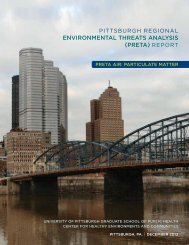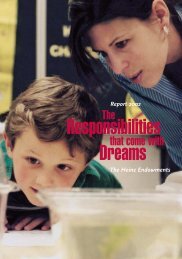View PDF - Heinz Endowments
View PDF - Heinz Endowments
View PDF - Heinz Endowments
Create successful ePaper yourself
Turn your PDF publications into a flip-book with our unique Google optimized e-Paper software.
1991, programs in Allegheny County in 1999:<br />
Tend to have more older children enrolled in nonschool-hour programs, are more likely to offer<br />
different activities for older children, and consequently place somewhat more emphasis on<br />
academic support activities, enrichment, and tutoring.<br />
- Shgw that approximately one-third of the directors of programs in the County have college degrees<br />
or higher, have a higher median of seven years experience in this field, and slightly morestafflave<br />
college degrees locally (28Eo) than nationally (2l%o).<br />
- Have less staff turnover locally (2IVo) rhan nationally (35Vo).<br />
- Have a staff:child ratio in the County (1:11) that is a bit poorer than the national average (l:9) but is<br />
at the professionally recommended minimum of l:10 for children less than 6 years and l:12 for<br />
children greater than 6 years of age.<br />
'<br />
Thus, in Allegheny County, the quality of care in structured center-type environments is only<br />
"averager" and most children in the County attend nonschool-hour services that are not licensed<br />
or regulated and in which staff are not necessarily trained or credentialed. Moreover, a set of<br />
recommended practices specifically for nonschool-hour programs does not exist. Therefore, some<br />
systems of standards, regulation, support for training, and subsidies and incentives for providers,<br />
agencies, and parents is likely necessary to raise the quality of nonschool-hour programming, centerbased<br />
and otherwise, toward a standard of excellence.<br />
FrnaNcHL AND Man¡,cnnnENT IssuES<br />
Agency Funding<br />
'<br />
Parent fees are the predominant form of financial support for agencies. Sixty-one percent of centerbased<br />
programs charged parents fees, and an estimated 797o of parcnts pay full fees as defined by the agency.<br />
- Subsidies are more common in programs serving low-income populations. Regulated programs<br />
primarily use public subsidies, while other programs provide parents discounts, sliding-fee<br />
scales, multiple-child discounts, and scholarships, with contributions from private foundations and<br />
government covering the difference between parent fees and costs.<br />
'<br />
'<br />
Funding remains a problem for many agencies. One+hird of the agencies surveyqd said sufficient<br />
funding was difficult to obtain to provide the physical and material resources they felt were needed and<br />
to hire and maintain staff.<br />
A variety of government and private funding is available, but not used to its fullest extent.<br />
- Funding for nonschool-hour progrâms is available from a variety of federal agencies. These<br />
include the U.S. Department of Education (Title I, Safe Schools Act of 1994, Title VII, Reading<br />
Excellence Act, 2lst Century Community Learning Centers), U.S. Department of Agriculture<br />
(Child and Adult Care Food Program, Cooperative Extension Services' Youth at RiJk Program),<br />
U.S. Department of Justice (Office of Juvenile Justice and Delinquency Prevention, Bureau of<br />
Justice Assistance), U.S. Department of Health and Human Services (Community School youth







